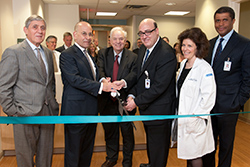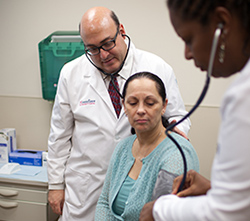

Aiding Women’s Health
Building Bridges to Advance Women's Health
For patients, clinical trials can be a bridge to novel, investigational therapies they can’t access otherwise, but may mean the difference between life and death. For researchers, trials are a bridge as well – from the bench to the bedside, from basic research to clinical practice. Now, with the establishment of a center focused on both obstetrical and gynecological clinical and translational research, these bridges are a lot easier to cross.

At the center’s ribbon-cutting ceremony (from left): Drs. Allen M. Spiegel, Steven M. Safyer, Irwin R. Merkatz, Mark Einstein, Marla Keller and Philip OzuahThe new center, which opened in early 2012, brings together the resources of Einstein and its university hospital, Montefiore Medical Center, into a single facility dedicated to clinical research in women’s health. With cutting-edge equipment, its staff of two dozen physicians, epidemiologists, study nurses, and research coordinators is well-prepared for that mission.
"The goal of this new clinical and translational research center is to provide our diverse group of patients innovative clinical trials so we can ultimately help them as well as our entire community with the breadth of information and new strategies and treatments for prevention and cure of disease," said Dr. Irwin R. Merkatz, professor and chair of obstetrics & gynecology and women’s health, and the Chella and Moise Safra Professor and University Chair of Obstetrics & Gynecology and Women’s Health. "By placing the enormous resources and knowledge of the best clinical practices and practitioners from the medical center and the best science from the medical school under one roof, we offer the ability to deliver the most innovative patient care."
"With our patient-centered team of clinicians and scientists, our new clinical research center is able to offer the most novel, state-of-the-art treatments, prevention strategies, and care to each of our patients," said Dr. Mark Einstein, center director and associate professor of obstetrics & gynecology and women’s health.

An example of clinical trials underway at the center"We can handle close to 40 clinical trials at once," noted Dr. Einstein. To date, these have included studies in ob/gyn and women’s health subspecialties such as oncology, infectious disease, and the growing field of urogynecology.
"It’s a wide range, but we take on trials that are relevant to the population we serve," he said. "Urban areas and some portions of our community have often been understudied. Now patients in the Bronx have access to the standard-of-care treatments of today, but also the treatments of tomorrow."
The center is ambulatory-based, and because it centralizes staff and other resources in one facility – located at 1625 Eastchester Road – it’s convenient for patients who might otherwise have to shuttle from one location to another during the course of a trial. To make visits even more convenient, extended evening hours are offered.
The 4,100-square-foot facility also makes for better research, because staff and equipment are easily accessible. For example, deep freezers are on-site and immediately available for investigators handling perishable specimens.
But staff members also are prepared to go where their patients are. "We have a large physical space, but we also go out to sites throughout the Bronx – for example, to collect tissue in research participants who are undergoing a surgical procedure," said Dr. Einstein. The goal is to be easily accessible to patients participating in trials, he said. "Our number-one priority in any trial is the patient and her optimal care."

Dr. Einstein and a member of the center’s clinical staff with a study participantAnother priority, according to Dr. Einstein, is training young investigators. Nearly 40 residents now work with the center, as well as students, fellows, and junior faculty. Dr. Hye Jung Heo, an assistant professor, is one of them. Dr. Heo, whose research specializes in maternal/fetal health, said, "This facility provides essential infrastructure for translational research, and represents a true collaboration between the clinical and research communities.
"Even if you have the best ideas, they remain just ideas if you don’t have the infrastructure to explore them."
The location is advantageous for researchers as well. "The Bronx represents a huge patient pool, and is known for its diversity. It’s at the center of the obesity epidemic and other health problems. So it’s a great starting point for clinical research," said Dr. Scott Chudnoff, an associate professor whose work has focused on surgical treatment of fibroids. "Traditionally, there aren’t a lot of clinical trial opportunities in women’s health, especially in urban areas. The center allows us to offer treatments to patients here who otherwise might not have access to them."
There also are facilities that patients might not find elsewhere. For example, it can be difficult for researchers to explain the risks and potential benefits of a clinical trial to patients – a crucial part of the informed consent process – because other clinical sites don't have quiet, private space for these sensitive discussions. "The center is unusual in that itincorporates sensitivity to patients in the research setting," Dr. Chudnoff said.
Dr. Jeny Ghartey agrees. An assistant professor who is investigating the link between infectious disease and pre-term birth, she said, "Other sites are just not set up to support women's health research so well. Here, the process is seamless for patients, and has improved the opportunity for researchers exponentially."
By making the work of women’s health research more seamless and efficient, the center allows Dr. Ghartey to do what she loves best. "I’m able to spend more time with patients, and to help them take a more active role in the research," she said. "To be able to see patients as their provider and also as a clinical investigator is simply wonderful."
Posted on: Thursday, July 18, 2013

Tablet Blog